there are a few things going on here. first as CDJB notes: if there were any positive solutions then sympy would find them. I searched for those numbers and found this paper which suggests you should be using 7088 instead of 8093. we can do a quick sanity check:
def pct(value):
return f"{value:.1%}"
print(pct(422 / 8093)) # ~5.2%
print(pct(422 / 7088)) # ~6.0%
confirming that you're going to struggle averaging ~5.9% and ~6.0% towards ~5.2%, and explaining the negative solutions in the other answers. further, these are presumably counts so all your variables also need to be whole numbers.
once this correct denominator is used, I'd comment that there are many solutions (11645 by my count) e.g:
cases = [1, 421]
pop = [17, 7071]
rates = [pct(c / p) for c, p in zip(cases, pop)]
gives the appropriate output, as does:
cases = [2, 420]
pop = [34, 7054]
this is because the data was rounded to two decimal places. you probably also don't want to use either of the above, they're just the first two valid solutions I got.
we can define a Python function to enumerate all solutions:
from math import floor, ceil
def solutions(pop, cases, rate1, rate2, err):
target = (pct(rate1), pct(rate2))
for pop1 in range(1, pop):
pop2 = pop - pop1
c1_lo = ceil(pop1 * (rate1 - err))
c1_hi = floor(pop1 * (rate1 + err))
for c1 in range(c1_lo, c1_hi+1):
c2 = cases - c1
if (pct(c1 / pop1), pct(c2 / pop2)) == target:
yield c1, c2, pop1, pop2
all_sols = list(solutions(7088, 422, 0.059, 0.060, 0.0005))
which is where I got my count of 11645 above from.
not sure what to suggest with this, but you could maybe do a bootstrap to see how much your statistic varies with different solutions. another option would be to do a Bayesian analysis which would let you put priors over the population sizes and hence cut this down a lot.
